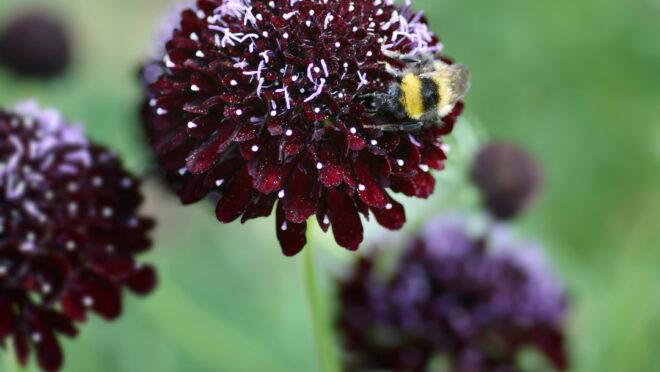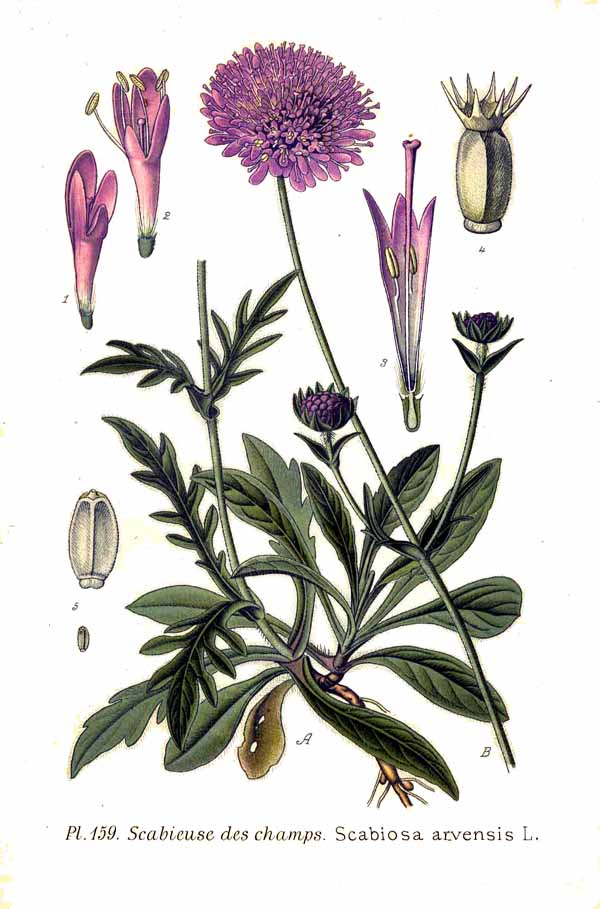Your basket is currently empty!

Short + sweet: Black scabiosa for your dye garden
Pincushion flower, Scabiosa atropurpurea
Scabiosa, or picushion flowers, come in a variety of colors, from very light like white or pale pink to deep dark red, almost black. I have them here as a 'black' variant,which might be the most exciting for the dye pot.
I find pincushion flowers quite charming - and also their doppelganger, the field scabiosa, which you can find in wild meadows. Do you already know them? How you can tell the two apart, see below! In any case, both species attract many insects to the garden.
The Dye seeds kit now also contains Pincushion flowers: A black variety (which actually is more of a deep dark purple) If you are looking to grow pincushion flowers specifically for dyeing, I'd recommend going for ones with the darkest, most saturated flowers, rather than those in light pastel colors.
The flowers are particularly suitable for bundle dye. They contain mainly anthocyanins as colorants.
You can also make a dye bath with them, but should keep in mind that the dyes are not too heat stable. In general, anthocyanins belong to the more volatile dyes. So they don't have particularly good lightfastness.
Because they complement the local color palette so nicely, I still like to have a few dye plants from this spectrum in the garden. And not every color has to be for eternity, right? In general, I use these colors mainly for bundle dyeing.
As for the practical side, these annual flowers are also delightfully uncomplicated in cultivation. I start a few seeds indoors. But they also germinate well at lower temperatures, so I sow the bulk in the garden, slightly protected in the cold frame. I think that's great, because at home in the growing rack and on the windowsills I'm always running out of space!
You can also sow them directly on the spot in early spring - in the cold frame the young plants are better protected from hungry slugs and birds which I know is important in my garden... In addition, I was not quite done yet with this year's garden planning, but didn't want to sow any later, so that was best for me.


Pincushion flower or Field scabiosa, what's the difference?
If you already know the field scabiosa (Knautia avensis), you may just be wondering what distinguishes it from pincushion flowers (also known as sweet scabiosa!) - that's definitely how I felt. Not much at first glance, I admit.
Both are assigned to the same subfamily, the cardaceae (teasel family). So they are closely related, but do not belong to the same genus, as I would have assumed as a non-botanist - but as so often, the first glance just doesn't reveal the whole story.
The field scabiosa also native to Germany, while pincushion flowers originate from more southern climes in the Mediterranean area. Why is that so important now anyway? First of all, I was just curious. And, other than pincushion flowers, I don't know any variant of the field scabiosa that has equally deep dark flowers. Their blooms range from lilac-purple to pink.
So I wanted to get to the bottom of it, and here's what I learned: there are several small distinctive features, but I find one in particular helpful.
Looking very closely at the individual flowers helps to tell them apart (even if you have ones with the same bloom color).
Both have flowerheads with a large number of individual flowers. If you look at these single flowers, you can tell the difference. In my drawing on the lower right - not a masterpiece, but hopefully sufficient - you see the field scabiosa above, where the corolla (=the individual flower) has four corolla lobes. Whereas the pincushion flower shows five of these.


Identifying plants
If you are also curious about plants, but like me were not trained how to, then here comes a little digression on identification for you. I am refering to two german books here, so you might have to do your own research for english ones.
Plant identification is not always easy, especially if it's new to you, and if you want to know it as accurately as possible. I myself am definitely no expert on that subject, and I'm always glad when I there are people around with more knowledge to ask. Definitely my favorite way, to learn from others.
Naturführer und Bestimmungsschlüssel
But there's not always someone around to ask... To get to the bottom of such questions, my field guides (for example ‚Was blüht denn da?‘*), which I like to carry with me outdoors are not always enough. And the various photo apps for plant identification can often give you a good idea about what type of plant's in front of you, but are not too reliable if you're after precise results.
A more detailed and precise approach to plant identification can be found in ‚Grundkurs Pflanzenbestimmung‘ von Rita Lüder*. This book is structured differently than the field guide, it uses an identification key.
Trying to work with this book for the first time I was a bit intimidated, as I had never used anything like it before. With the key you work your way from question to question.
Based on the characteristics of the plant, you first determine the plant family, and get closer and closer to the species. Not always successfully – sometimes the key asks for flowers or seeds which may not always be visible.
With identification keys you learn to distinguish systematically between plant families and species, while field guides are often sorted by e.g. flower color or leaf shape and then sort the species according to that - here you leaf through and try to find the illustration and description that matches your plant best.
Identification keys for plants can be quite extensive, and might be overwhelming for beginners. Also not necessarily suitable to have them in the backpack on every walk. With the Rita Lüder's key, you can get a taste of whether this type of book appeals to you, and familiarize yourself with the method.
In any case, I find it a very exciting topic!
*Wenn du ein Buch über den Link kaufst, bekomme ich eine kleine Provision von meinem Partner buch7.de, der Preis für dich bleibt gleich. Die Bestellung über den sozialen Buchhandel buch7.de unterstützt soziale, kulturelle und ökologische Projekte – und mir hilft sie auch.
Leave a Reply